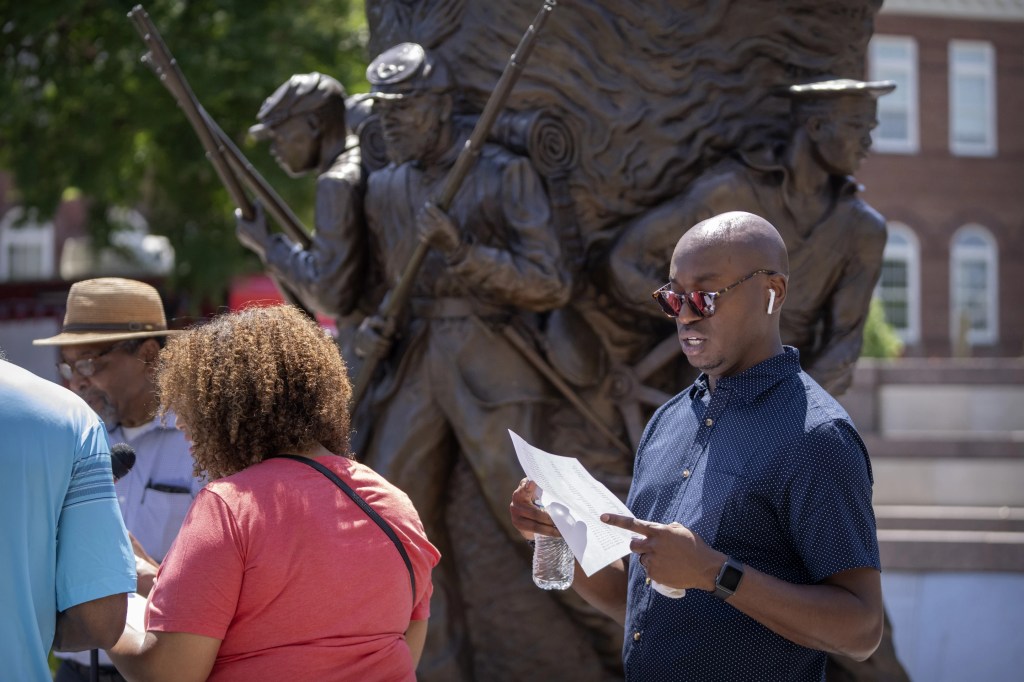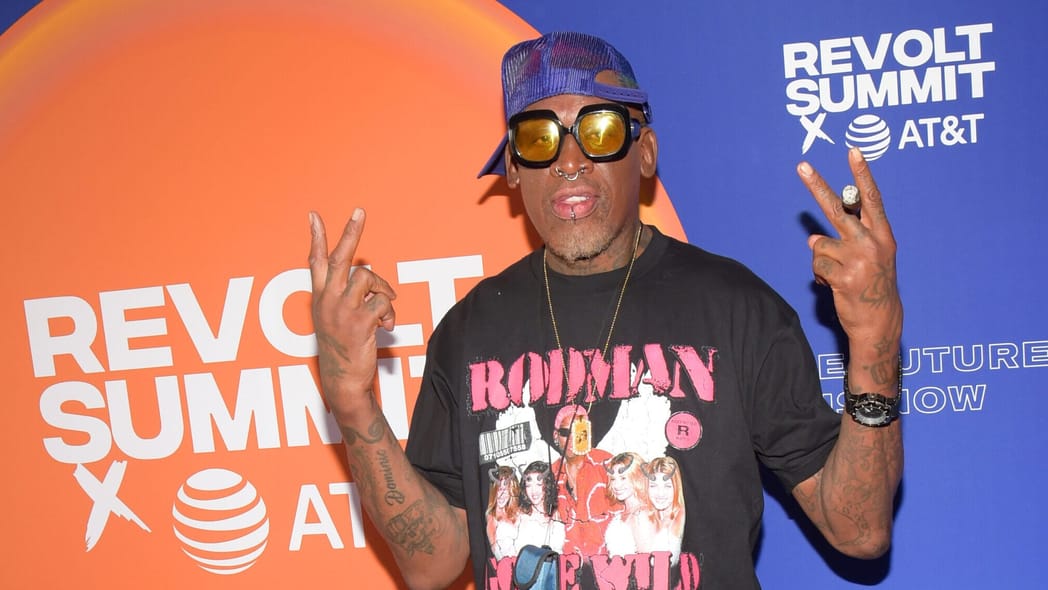On Juneteenth, a journalist honors ancestor at ceremony for Black soldiers who served in Civil War
Associated Press reporter Darren Sands reflects on discovering his family legacy
WASHINGTON (AP) — It was the middle of the night in the summer of 2021 when I — Darren Sands — finally found the missing piece of my family history.
My great-great-great-great grandfather Hewlett Sands, born into slavery in Oyster Bay, New York in 1820, was one of the more than 200,000 names listed on the African American Civil War Memorial in Washington, D.C. That meant he was a soldier who served in a United States Colored Troops regiment that fought for the Union – and the freedom we still celebrate today.
As the screen glowed, a mix of emotions — anxiety, elation, pride — washed over me. It was the first step in understanding the story of his life. I want to share what I know about him!
I had to resist the urge to race to the Spirit of Freedom statue and trace my fingers over his name etched on the nearby Wall of Honor. I held off until the sun came up.
This Juneteenth I returned to the memorial to honor him and all who served our country, one that spent its first two centuries seeing most of its Black people as someone else’s property. In a special ceremony Wednesday, I was helping carry on the more than 150-year-old commemoration of enslaved people in Galveston, Texas, finding out on June 19, 1865, that they’d been freed. It’s been a longtime sacred celebration for many Black Americans, but only recently was recognized as a federal holiday.

I didn’t go just for myself or my family. I also wanted to celebrate Frank Smith, a civil rights leader and the memorial’s director, whose work preserving this lesser-known American history helped me understand where I came from and who I was.
One of Smith’s biggest wishes is for the National Parks Service to assign a full-time ranger to the memorial site. If there was ever a candidate, it would be Marquett Awa-Milton. I first met him when I came to find my ancestor’s name. He serves the memorial daily in full Civil War regalia, and was taking selfies and gladhanding visitors with his rifle sticking above his head as I arrived.
Soon, the ceremony began. Smith, who once presided over this event with just his staff and very little fanfare, opened the ceremony by welcoming about 150 people, many tucked under the shade as temperatures rose. Smith then asked me and two-dozen other volunteers to read the names of soldiers who were in Galveston when the war ended, including the 26th Regiment. After I read Hewlett Sands’ name aloud, I took my wife, Jummy, by the hand and showed her the tiny corner of the memorial symbolizing his sacrifice. I felt again the same mix of pride and gratitude I first felt in the summer of 2021.
“Congratulations on finding your ancestor,” Smith had told me again last week, as he had after he first told me in 2021 after I found my connection to Hewlett Sands. I think it is what he says to everyone who finds their ancestor on the wall, a thank you for all those men who sacrificed.
I learned about Hewlett Sands while researching my family’s history, hoping to interweave it into a book I’m writing about Coretta Scott King’s work to try and transform America into a nonviolent society after the assassination of her husband, Martin Luther King Jr. in April 1968.
Over the many decades since the Civil War, there was a lot of displacement among my ancestors; people moved away and never came back and a lot of our family stories were lost.
But I do know that the Sands men served valiantly in World War II. There was a newspaper headline about “The Sands Family Fights” with a photograph of several of them. We knew a lot more about World War II than the Civil War.
According to the records I found, Hewlett Sands was born on Nov. 29, 1820, in the home of the Townsend family, a wealthy and powerful family on Long Island who held many enslaved people before New York abolished slavery in 1827.
It’s not clear to me how he spent much of his life between 1820 and 1852. He apparently worked as a farm laborer, and even as a clam digger. When he was 32, he met and married a young widow named Anne Amelia Payne, who took Sands as her last name.
In April 1861, Confederates fired on Fort Sumter in South Carolina, igniting the Civil War.
In January 1864, Hewlett Sands would collect a $300 bounty and join the 26th United States Colored Troops infantry regiment, which prepared for war along with thousands of other soldiers on Riker’s Island. His enlistment papers say he was 42, but in fact he was about to turn 44.
According to military records, his regiment — after enduring rugged conditions in camp — boarded a ship named Warrior in March 1864 bound for South Carolina, where they fought in the battle at Honey Hill and other engagements.

Life after the war for Hewlett Sands was defined by a series of economic hardships. He fell and lost vision in one eye; and he lost an inheritance he intended to pass down to his family through the generations. He died on April 8, 1901, at the age of 81.
But his and Amelia’s son, James Edward Sands, got married and had two children, one of whom was Alfred Sands. Among Alfred’s children was my grandfather Alonzo, who served with his brothers in World War II. In June 1960, Alonzo and Catherine Sands gave birth to a boy, Lonnie, who is my dad.
Like Hewlett Sands, I grew up in Long Island, in the town of Roslyn, where I developed a love for reading. I first read about the life of Martin Luther King at the Bryant Library, and by age 11 was giving speeches about him and his impact on my life. It was in Roslyn, as a boy, that I decided I wanted to be a journalist, after a compassionate Newsday reporter visited to get our family’s side of the story in an article about a neighborhood controversy.
Recommended Stories
Now, working on this Juneteenth story as a journalist, I feel it’s part of my mission to educate and inform people about all this. And to be able to share it with my dad, my mom — all of my family.
I have a very strong sense of connection to the idea Hewlett Sands risked his life for not just his family, but for a higher ideal. I think all those men shared a sense of doing something that was going to impact generations that they would never meet.
No one living had ever seen Hewlett’s grave, and I went just the other day. On a cloudless day, my dad and I discovered his tombstone, inscribed Co. D 26th U.S. INF. Somehow, we felt a little closer to him, and a little closer to each other.
More About:Juneteenth News









